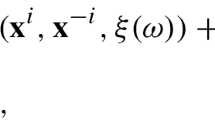Abstract
In this paper, a regularized version of the Extraproximal Method together with a Stochastic Approach is suggested to calculate the Stackelberg–Nash equilibrium in a N-person finite game. In this game, two levels of hierarchy in decision making are considered: one leader and (\(\hbox {N}-1\)) followers. Here, the followers playing according to the Nash equilibrium concept among themselves to the leaders announced strategy. An Extraproximal Technique is used to realize the application of a two-step procedure for finding the Nash equilibrium corresponding for the followers providing the loss function for a leader: at the first (or preliminary) step some predictive approximation of the a current approximation is calculated, at the second step (the main step of the iteration) this prediction is used to complete the current iteration. The next step, applying the stochastic gradient projection technique suggested, the Stackelberg–Nash equilibrium is found. The optimality conditions for a strategy being an equilibrium in participants game are derived based on the strong convexity of the \(\delta \)-regularized loss function. Simulation results illustrate the feasibility and the performance of this method.



Similar content being viewed by others
References
Basar T, Olsder GJ (1995) Dynamic noncooperative game theory, 2nd edn. SIAM, Philadelphia
Nash J (1950) Equilibrium points in n-person games. Proc Natl Acad USA 36(1):48–49
Von Stackelberg H (1952) The theory of the market economy. Oxford University Press, Oxford
Moya S, Poznyak A (2009) Extraproximal method application for a Stackelberg-Nash equilibrium calculation in static hierarchical games. IEEE Trans. Syst. Man Cybern. Part B Cybern 39(6):1493–1504
Poznyak A, Najim K, Gomez-Ramirez E (2000) Self-learning control of finite Markov chains. Marcel Dekker, New York
Colson B, Marcotte P, Savard G (2005) Bilevel programming: a survey. Q J Oper Res 3:87–107
Tanaka K, Yokoyama K (1991) On \(\varepsilon \)-equilibrium point in a noncooperative \(n\)-person game. J Math Anal Appl 160:413–423
Aubin JP (1979) Mathematical methods of game and economic theory. North Holland, Amsterdam
Poznyak A (2008) Advanced mathematical tools for automatic control engineers. Vol 1: deterministic techniques. Elsevier, London
Antipin AS (2005) An extraproximal method for solving equilibrium programming problems and games. Comput Math Math Phys 45(11):1893–1914
Polyak BT (1987) Introduction to optimization. Optimization Software, Publication Division, New York
Poznyak A (2009) Advanced mathematical tools for automatic control engineers. Vol 2: stochastic techniques. Elsevier, London
Kuhn HW, Tucker AW (1951) Nonlinear programming. In: Proceedings of the 2nd Berkeley symposium on mathematical statistics and probability Berkeley. University of California Press, pp 481–492
Acknowledgements
The author thanks to the Instituto Mexicano del Petrleo for their support and authorization to present this document.
Author information
Authors and Affiliations
Corresponding author
Rights and permissions
About this article
Cite this article
Moya, S. The calculation of the Stackelberg–Nash equilibrium as a fixed point problem in static hierarchical games. Int. J. Dynam. Control 6, 907–918 (2018). https://doi.org/10.1007/s40435-017-0311-0
Received:
Revised:
Accepted:
Published:
Issue Date:
DOI: https://doi.org/10.1007/s40435-017-0311-0




